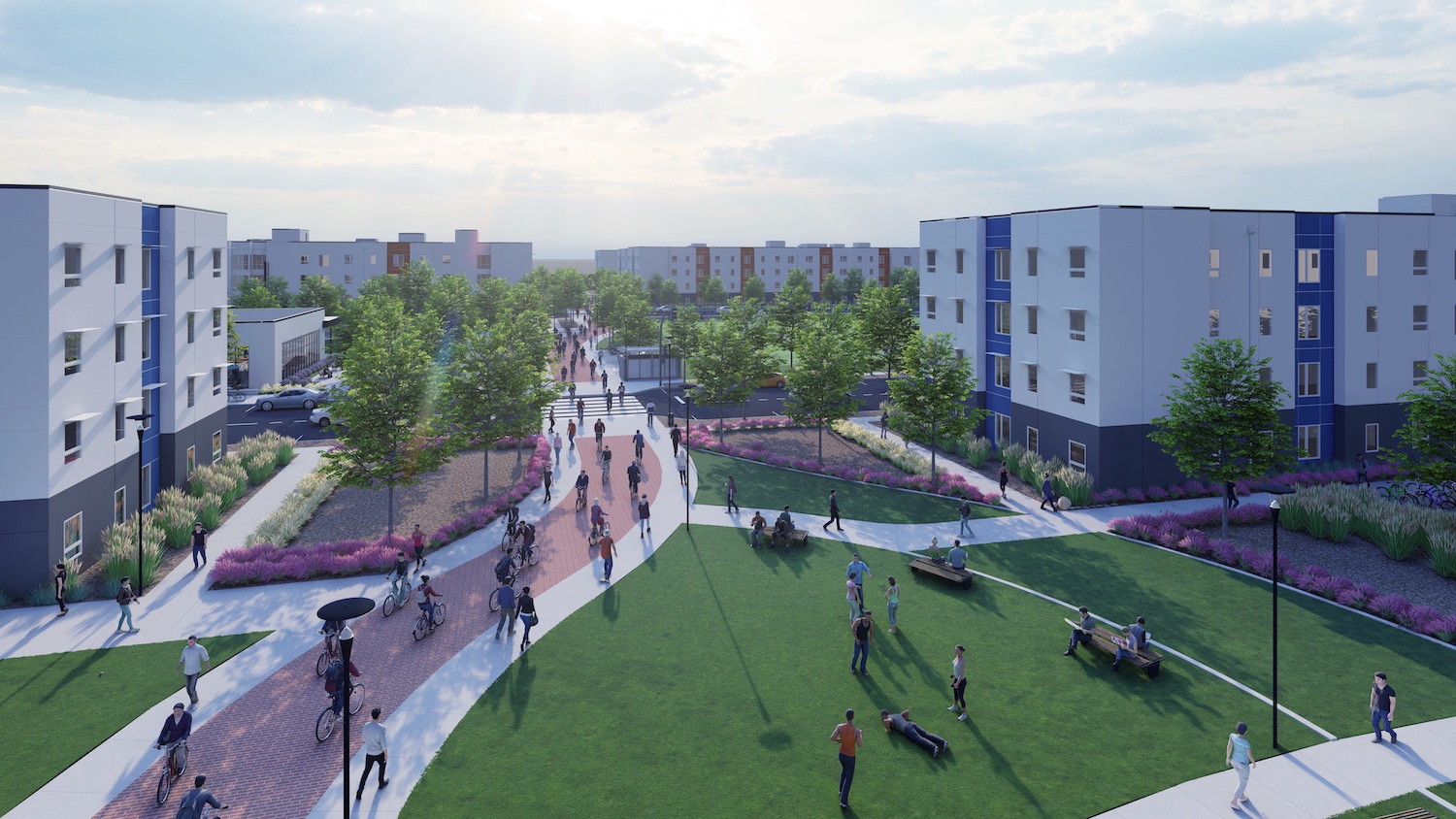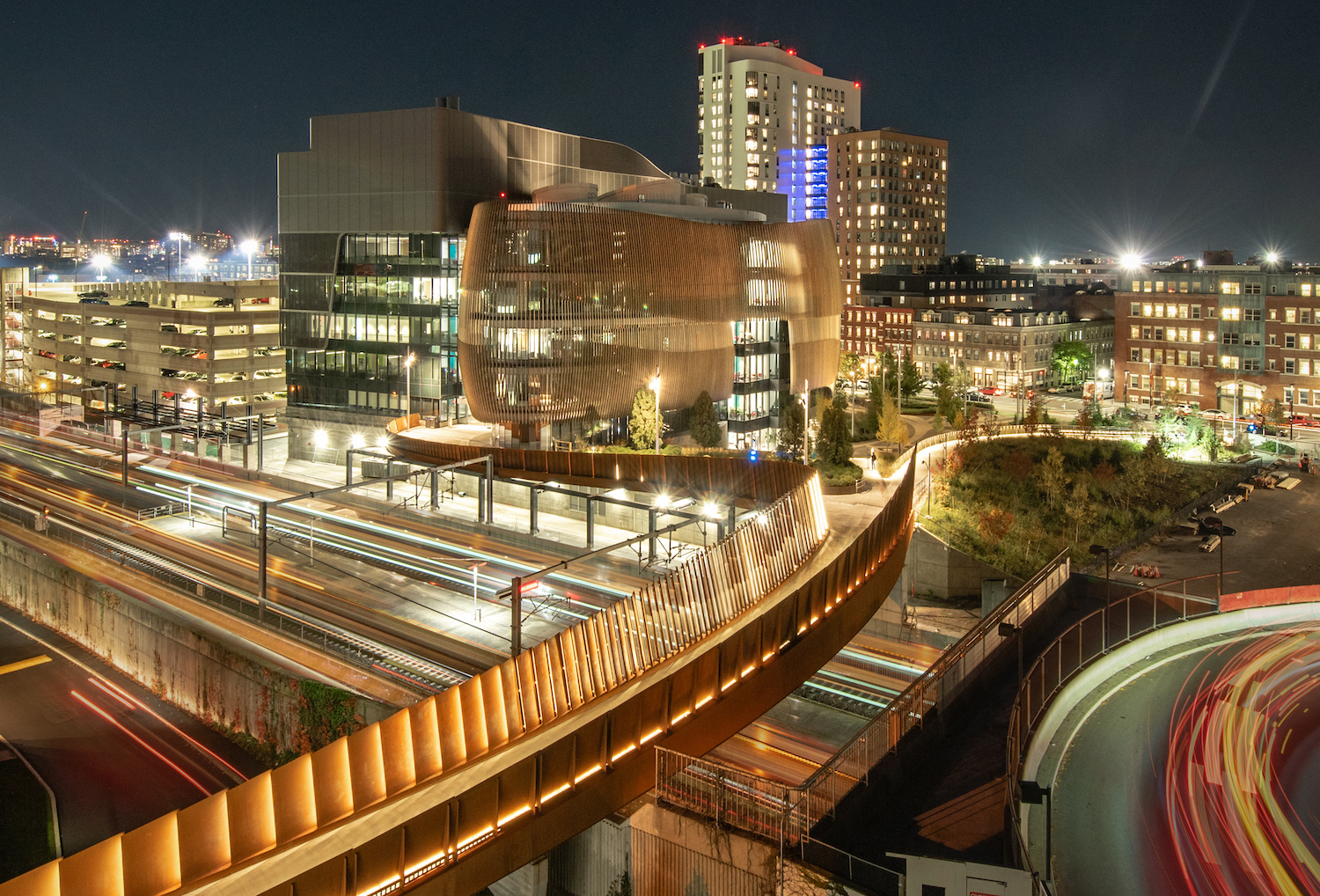Will online learning become a staple for America’s colleges and universities, even after the coronavirus subsides? And if it does, what will that mean for existing and future buildings on campuses across the country?
These have become a fundamental—even existential—questions that AEC firms say their higher ed clients are pondering. While online learning isn’t expected to replace classroom learning over the long run, some firms already see a movement brewing that favors a hybrid model offering collegians both options.
“Colleges and universities are taking immediate steps to de-densify classrooms and residence halls, forcing many institutions to adopt a hybrid pedagogical model whereby approximately one-third of students will receive in-person instruction concurrent with online instruction,” says Patrick McCafferty, Principal and Education Business Leader at Arup’s Boston office. Arup is already sensing diminishing demand for large lecture halls. (McCafferty wonders, though, if a hybrid model might inadvertently create a tiered student experience.)
Chris Purdy, AIA, LEED AP, Vice President and Higher Education Practice Director for SmithGroup, anticipates a “widespread acceptance” of the hybrid learning format. He adds that campus de-densification will require rapid, data-driven strategic planning. Erin Joseph Machau, Jacobs’ Higher Education Market Leader, sees these trends inevitably leading toward more modular and flexible design.

Northeastern University Interdisciplinary Science and Engineering complex. Photo: Tanguy Marquis
“Higher Education will rebound, but the type of projects needed will change,” predicts Machau. “Campus and departmental master planning, facility condition assessments, building and space inventory, and other consulting services will likely increase in need,” as universities lick their wounds from revenue losses, and reboot their space needs in light of what the “campus experience” and “student living” actually mean these days.
“COVID-19 has opened the door for campuses to make big changes for themselves and for their students,” says Tracy De Leuw, DPR Construction’s Higher Ed Core Market Leader. He, too, thinks more schools will focus on hybrid solutions that include combining multiple disciplines—such as business and finance with computer engineering and science—into mini think tanks.
Hybrid learning—such as the HyFlex course design model that gives students the option of attending classes online or physically—depends on technology. Schools are already leveraging technology to offset the impact of social distancing, says Damon Sheppard, HOK’s Regional Leader of Science + Technology. The shift toward learning from home could also spur greater demand for data centers and infrastructure investments, suggests Paul Erb, Executive Vice President for McCarthy Building Companies.
P3s could shore up shortfalls in the university sector
The embrace of hybrid learning, be it tentative or gung-ho, comes at a time when universities are staring at some stark economic realities. The higher education sector is girding for at least a 10% revenue reduction this year as a result of the coronavirus. The suspension of classes and the evacuation of student housing were major hits to many schools’ revenue streams. And going forward, will schools be able to justify what they charge for tuition if courses are delivered online?
The virus “created an unsustainable business model and operating budget gaps,” says Sean Edwards, Suffolk Construction’s COO for Higher Education. That led to pauses in new construction of many capital projects, and slowdowns in the planning and design of projects that weren’t already underway. Erb of McCarthy elaborates that while most of his firm’s higher ed projects already in design are moving forward, future projects have been “pushed out” farther.
Even PCL Construction, which as of mid-June had 23 higher ed projects under construction, expects universities to experience revenue losses from social distancing requirements and the downsizing of dorms, which could force more students into off-campus housing, says Bob Hopfenberg, the firm’s Vice President of National Business Development. PCL predicts more separation within classrooms, and modifications to dorms and residence halls that reduce student occupancies.

Under construction on the campus of the University of California at Davis is the nation’s largest public-private partnership for a student housing project in the U.S. Stantec, The Michaels Organization, and CGB Building Company are part of the team for this complex, which will have 1,875 student beds within nine four-story apartment buildings. Rendering: Stantec
Several AEC firms say their university clients are turning more aggressively to public-private partnerships (P3s) to finance future campus renovation and construction. One of Stantec’s higher ed jobs under construction is at the University of California–Davis: the nation’s largest P3 student housing project to date.
“If universities can’t keep up with demand, they can turn to the private sector for facilities to accommodate student housing and dining,” observes Brent Amos, Principal and Secretary-Treasurer for Cooper Carry. Arup’s McCafferty thinks there will be renewed interest in funding initiatives and investment streams associated with biological sciences and medical research.
The economic turmoil caused by the coronavirus will also thin the herd. Suffolk’s Edwards foresees some smaller institutions merging or being acquired by larger universities. Such consolidations could create opportunities for mixed-use developments that have synergies with universities, such as research labs or commercial space. Other private institutions that don’t choose the P3 or consolidation route might seek to monetize their land assets to generate capital for future construction.
Reassessing space needs in college buildings
The pandemic gave colleges and universities a pressing reason to reevaluate their assets, in order to figure out how they fit into longer-term sustainability plans. For example, about 30% of a typical campus footprint is currently used for administrative and faculty space, notes Patricia Bou, AIA, CannonDesign’s Co-Director–Education Market. Her colleague Charles Smith, AIA, believes that S+T and research facilities could gain importance as part of cross-disciplinary education. “The same goes for healthcare and medical education,” says Smith. “We’re thinking about how to address the intersection of health, science, and data.”
They also suggest that academic institutions should think about alternative uses for dining facilities and recreation centers if their on-campus populations are going to get smaller.
Priorities might change relative to building needs, with a shift in focus toward more adaptation of existing buildings or enhancement of building systems, say Summer Heck, Marketing and BD Manager-Education and S+T at Stantec’s office in Raleigh-Durham, N.C.; and Stephen Phillips, a Vice President at the firm’s Toronto office. “The pandemic will reinforce the rise of renovation and adaptive reuse projects, a trend we’ve been seeing in recent years,” concurs Cooper Carry’s Amos.

Emory University’s Health Research Science Building 2 is scheduled to open in Atlanta in 2022. HOK’s design supports Emory’s campus-wide sustainability efforts and aggressive goals for energy use reduction. Rendering: HOK
Stantec’s executives are seeing a continued focus on career and technical education and skills development. And innovation centers “are at the forefront on institutions’ minds,” they say.
Design professionals like HOK’s Sheppard are now being asked to consider academia’s long-term space strategies, and not just the short-term physical impacts of COVID-19. To that end, Sheppard sees HOK’s role evolving to help clients define how campus space supports their schools’ core missions, determine how much physical space is needed by typology, and assess the value of that space via post-occupancy evaluations.
Suffolk, says Edwards, has moved toward design-assist delivery and virtual design and construction tools to reinforce its expertise to university clients for space planning, building systems, operations, and maintenance.
SmithGroup’s Purdy says his firm is seeing “some exciting opportunities,” including major projects budgeted at $200 million or more, through the firm’s Scenario Mapping projects and CampusForward research. “We are going beyond sustainability and acute shocks, such as earthquakes and floods, to address future disease outbreaks and the chronic stresses of justice and equity.” The goal, he says, is to re-establish the “value” of the on-campus experience.
Related Stories
| Aug 11, 2010
Polshek unveils design for University of North Texas business building
New York City-based architect Polshek Partnership unveiled its design scheme for the $70 million Business Leadership Building at the University of North Texas in Denton. Designed to provide UNT’s 5,600-plus business majors with a state-of-the-art learning environment, the 180,000-sf facility will include an open atrium, an internet café, and numerous study and tutoring rooms—al...
| Aug 11, 2010
Cooper Union academic building designed to reach LEED Platinum
Morphosis Architects and Gruzen Samton are collaborating on an ultra-green academic building for New York’s Cooper Union that is designed to achieve LEED Platinum certification. The program for the nine-story facility mixes state-of-the-art laboratories, classrooms, a multipurpose auditorium, and a range of public and social spaces.
| Aug 11, 2010
Utah research facility reflects Native American architecture
A $130 million research facility is being built at University of Utah's Salt Lake City campus. The James L. Sorenson Molecular Biotechnology Building—a USTAR Innovation Center—is being designed by the Atlanta office of Lord Aeck & Sargent, in association with Salt-Lake City-based Architectural Nexus.
| Aug 11, 2010
Construction begins on Louisiana State Sports Hall of Fame
Heavy construction and foundation work has started on the new Louisiana State Sports Hall of Fame and Regional History Museum in Natchitoches, La. Designed by Trahan Architects, Baton Rouge, the $12 million, 28,000-sf museum will be clad in sinker cypress planks as a nod to the region’s rich timber legacy and to help control light, views, and ventilation throughout the facility.
| Aug 11, 2010
Modest recession for education construction
Construction spending for education expanded modestly but steadily through March, while at the same time growth for other institutional construction had stalled earlier in 2009. Education spending is now at or near the peak for this building cycle. The value of education starts is off 9% year-to-date compared to 2008.
| Aug 11, 2010
Perkins Eastman awarded Indian School of Business campus
The New York office of Perkins Eastman has been commissioned by the Indian School of Business for a 70-acre, 1.5 million-sf new business school campus as part of a 300-acre “Knowledge City” in Chandigarh, Mohali, India. The sustainable campus will accommodate four centers of excellence: healthcare management, public policy, manufacturing/operations, and physical infrastructure manag...
| Aug 11, 2010
Opening night close for Kent State performing arts center
The curtain opens on the Tuscarawas Performing Arts Center at Kent State University in early 2010, giving the New Philadelphia, Ohio, school a 1,100-seat multipurpose theater. The team of Legat & Kingscott of Columbus, Ohio, and Schorr Architects of Dublin, Ohio, designed the 50,000-sf facility with a curving metal and glass façade to create a sense of movement and activity.
| Aug 11, 2010
Residence hall designed specifically for freshman
Hardin Construction Company's Austin, Texas, office is serving as GC for the $50 million freshman housing complex at the University of Houston. Designed by HADP Architecture, Austin, the seven-story, 300,000-sf facility will be located on the university's central campus and have 1,172 beds, residential advisor offices, a social lounge, a computer lab, multipurpose rooms, a fitness center, and a...
| Aug 11, 2010
University of Florida's traditionally modern graduate building
The University of Florida's Hough Hall Graduate Studies Building was designed by Rowe Architects, Tampa, and Sasaki Associates, Boston, to blend with the school's traditional collegiate gothic architecture outside, but reflect a 21st-century education facility inside. Tallahassee-based Ajax Building Corporation is constructing the $19 million facility, which will have traditional exterior detai...
| Aug 11, 2010
Construction under way on LEED Platinum DOE energy lab
Centennial, Colo.-based Haselden Construction has topped out the $64 million Research Support Facilities, located on the U.S. Department of Energy’s National Renewable Energy Laboratory (NREL) campus in Golden, Colo. Designed by RNL and Stantec to achieve LEED Platinum certification and net zero energy performance, the 218,000-sf facility will feature natural ventilation through operable ...







